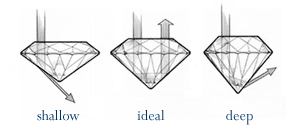Cut Determines Brilliance
The diamond's proportions, specifically the depth compared to the diameter, and the diameter of the table compared to the diameter of the diamond, determine how well light will reflect and refract within the diamond.
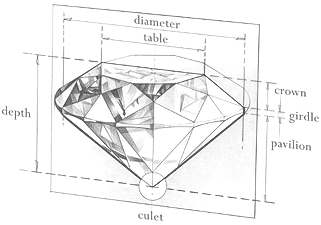
Diameter: The width of the diamond as measured through the girdle.
Table: The largest facet of a gemstone.
Crown: The top portion of a diamond extending from the girdle to the table.
Girdle: The narrow band around the widest part of a diamond.
Pavilion: The bottom portion of a diamond, extending from the girdle to the culet.
Culet: The facet at the tip of a gemstone. The preferred culet is not visible with the unaided eye (graded "small" or "none").
Depth: The height of a gemstone measured from the culet to the table.
Polish & Symmetry Affect Sparkle
Polish and symmetry are two important aspects of the cutting process.
The polish grade describes the smoothness of the diamond's facets, and the symmetry grade refers to alignment of the facets.
With poor polish, the surface of a facet can be dulled, and may create blurred or dulled sparkle. With poor symmetry, light can be misdirected as it enters and exits the diamond. The polish and symmetry grades are clearly listed in each diamond detail page and within the AGSL or GIA diamond grading report.
For the most beautiful diamond, look for a symmetry grade of ideal (ID), excellent (EX), very good (VG), or good (G) for an AGSL graded diamond, and excellent (EX), very good (VG), or good (G) for a GIA graded diamond. Avoid diamonds with symmetry grades of fair (F) or poor (P), as the alignment of their facets may misdirect light so severely that it affects the brilliance of the diamond.
Diamond measurements are calculated and applied to a cut grading scale that makes it easy to understand how well each reflect light.
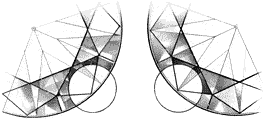
Which Diamond Cut Grade is Best?
For the best value in a brilliant diamond, choose a diamond with a cut grade of good or very good, and polish and symmetry grades of very good or good.
In an ideal- or very-good cut diamond with very good or good polish and symmetry, consider less expensive grades of color and clarity — look for a diamond with G or H color and SI1 or SI2 clarity.
Diamond Color
Acting as a prism, a diamond can divide light into a spectrum of colors and reflect this light as colorful flashes called fire. Just as when looking through colored glass, color in a diamond will act as a filter, and will diminish the spectrum of color emitted. The less color in a diamond, the more colorful the fire, and the better the color grade.
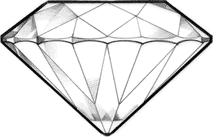
D: Absolutely colorless. The highest color grade, which is extremely rare.
E: Colorless. Only minute traces of color can be detected by an expert gemologist. A rare diamond.
F: Colorless. Slight color detected by an expert gemologist, but still considered a "colorless" grade. A high-quality diamond.
G-H: Near-colorless. Color noticeable when compared to diamonds of better grades, but these grades offer excellent value.
I-J: Near-colorless. Color slightly detectable. An excellent value.
A Note About Fluorescence
Some people seek diamonds that produce this unique effect, while others definitely avoid it.
The visible effects of fluorescence grades of faint, inert, negligible, and medium, can only be detected by a trained gemologist.
A fluorescence grade of strong or very strong can make a diamond with a near-colorless grade look even whiter yet in some instances give the diamond a slight hazy or oily appearance. Diamonds with a strong or very strong fluorescence are priced slightly lower than other diamonds.
What Color Grade Is Best
For the purist, look for a colorless diamond with a grade of D-F and a fluorescence rating of faint, inert, none, or negligible.
For an excellent value in a diamond with no noticeable color to the unaided eye, look for a near-colorless grade of G-I, and a fluorescence grade of medium or strong blue.
Or, if you'd rather not compromise on color but would like to stay on budget, choose a diamond with a good cut, SI1–SI2 clarity, and consider going with a strong fluorescence. It will still be beautiful to the unaided eye and you may prefer the unique effect of a strong fluorescence.
Diamond Clarity
Diamonds that are absolutely clear are the most sought-after and therefore the most expensive. But many diamonds have inclusions — scratches, trace minerals or other tiny characteristics that can detract from the pure beauty of the diamond. The GIA and EGL use a detailed system of rules and standards to summarize the number, location, size, and type of inclusions present in a diamond.
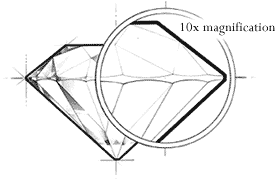
FL, IF Diamonds: Flawless: No internal or external flaws. Internally Flawless: No internal flaws. Very rare and beautiful diamonds.
VVS1, VVS2 Diamonds: Very, Very Slightly Included: Very difficult to see inclusions under 10x magnification. An excellent quality diamond.
VS1, VS2 Diamonds: Very Slightly Included: Inclusions are not typically visible to the unaided eye. Less expensive than the VVS1 or VVS2 grades.
SI1, SI2 Diamonds: Slightly Included: Inclusions are visible under 10x magnification, and may be visible with the unaided eye. A good diamond value.
I1, I2, I3 Diamonds: Inclusions are visible.
What Clarity Grade Is Best
We recommend that you select an "eye-clean" diamond — one that has no inclusions visible to the unaided eye. An excellent value, diamonds of this clarity are much less expensive than IF- or FL-grade diamonds and typically do not contain visible inclusions that detract from the beauty of the diamond. If you're considering an SI grade diamond, call to speak to a diamond and jewelry consultant who will review the diamond to ensure the inclusions are not visible with the unaided eye. But, if you'd rather not compromise on clarity yet are budget conscious, choose a diamond with a good cut and G or H color.
Diamond Carat Weight
Once you've determined what cut, color, and clarity grade you're looking for in a diamond, it's easy to determine the carat weight of diamond that will fit within your budget.
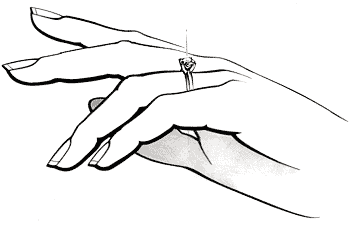 Use this chart as a relative guide only. (Actual sizes will vary with different monitor settings.)
Use this chart as a relative guide only. (Actual sizes will vary with different monitor settings.)
This chart illustrates how diamonds of different carat weights look when set in a ring. Note that a 2-carat diamond does not appear to be twice the size of a 1-carat diamond when viewed from the top.
When diamonds are mined, large gems are discovered much less frequently than small ones, which makes large diamonds much more valuable. In fact, diamond prices rise exponentially with carat weight. So, a 2-carat diamond of a given quality is always worth more than two 1-carat diamonds of the same quality.
What Size Diamond Is Best
To choose the best carat weight of diamond, consider her style, the size of her finger, the size of your setting, and your budget.
If you have a set budget, explore all your options and you'll find that there is a wide range of diamond carat weights and qualities available in your price range.
If your recipient is very active or not used to wearing jewelry, she may find herself bumping or nicking her new ring. Consider a smaller size diamond or a setting that protects a larger diamond from getting knocked against doors and counters.
Also keep in mind that the smaller the finger, the larger the diamond will appear. A 1½-carat diamond solitaire looks much larger on a size 4 finger than a size 8.
Finally, if a large carat weight is important to you, yet you're working within a budget, consider a diamond with a good cut, SI1–SI2 clarity, and an I or J color grade.
